Andrew Avitt, Office of Communication, November 29, 2021
The Joint Chiefs’ Landscape Restoration Partnership between the Forest Service and Natural Resources Conservation Service aims to restore landscapes, protect water quality, enhance habitat, and reduce wildfire threats to communities across the country. This is a story about fish habitat and how one project known as the Salmon SuperHwy is connecting land-owners and streams across Oregon.
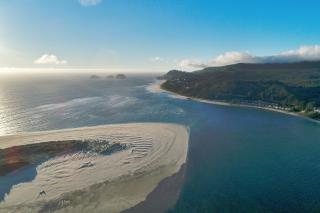
Salmon are always on the run. Traveling thousands of miles over the duration of their lives.
In Oregon’s Tillamook- Nestucca watershed, the fish make their travels along many rivers, streams, and tributaries, swimming from their natal streams deep inland out to the ocean and back again. They travel along the interconnected waterways like a car on a highway. But over the last 60 years that highway has become increasingly disconnected by barriers threatening fish populations, ecosystems, recreation, and industry.
The Barriers
“The most obvious type of barrier is a dam,” said James Capurso a Forest Service regional fisheries biologist stationed in Portland, Oregon. “But the most common and seemingly harmless barriers are culverts that allow water to pass underneath roads.”
Although the culverts allow water to pass, they are often undersized. During periods of heavy rain, the restricted flow functions like a firehose as large quantities of water are forced through a small opening. This creates velocities that make it hard — if not impossible — for fish to swim against upstream during their spawning runs.
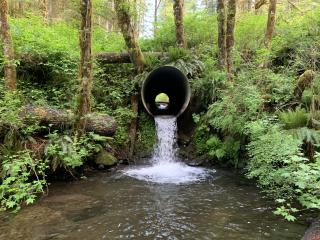
“These barriers, culverts, don’t act like a stream would,” said Capurso, who has worked in the Forest Service to restore connectivity of the streams in the pacific northwest for 35 years. “Decades ago, they weren’t thinking of the function of a stream ecosystem. They were more concerned with getting the water from one side of the road to the other.”
By not matching the gradient of the stream channel, the outlets of culverts are also sometimes above the water, which would require fish to jump up into the culvert to make its way up stream. The distance above the water tends to also increase over time as the waterfall effect creates a bigger scour and an even bigger jump.
Anyone who has taken a trip across the countryside knows that over stream crossing and the associated culverts are not just common, they’re pervasive.
“These barriers at road-stream crossings were typically addressed on a case-by-case basis, in piece meal fashion,” said Capurso, “A preferred approach would be to have more coordination between landowners and to direct resources towards the highest priority barriers.”
In 2012, land managers of the Tillmook- Nestucca watershed came together and compiled the data, prioritizing a list of all the different barriers across the landscape to reconnect whole segments of waterway.
“When we put that list together, we realized we had more than 3,600 barriers on national forest system land in Washington and Oregon alone, and that we would also need to collaborate with state and privately managed lands to successfully reconnect the waterways,” Capurso said.
The Fellowship of Barrier Removal
The fellowship of federal, state, commercial, and private landowners was assembled to reconnect the waterways. They mapped the barriers, prioritized projects and gave the collaborative endeavor a name– the Salmon SuperHwy.
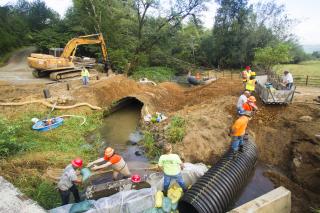
“The project is taking a whole landscape approach looking at the entire subbasin with a goal of connecting 180 miles of blocked habitat, 93 barriers, in the span of 10 years,” said Sarah Zwissler, a Trout Unlimited employee and the Salmon SuperHwy coordinator. “This isn’t something that has really been done before and may serve as a proof of concept for use in other watersheds across the country.”
Since the project’s inception and burgeoning support, 43 of the 93 priority barriers have been removed, and more than 115 miles of habitat reconnected.
“We’re over halfway to our goal of 180 miles,” said Zwissler, “Salmon are a cornerstone species for the Pacific Northwest ecosystem, and an iconic species, but the Salmon Superhighway does not just benefit aquatic life, it also supports healthy forests, and local economies.”
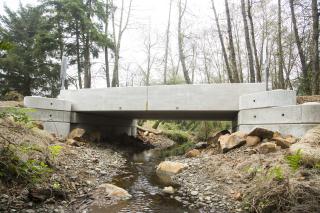
The life of migratory fish like salmon are vital to healthy ecosystems. After the juveniles hatch upstream, they swim out into the ocean, where they spend several years feeding, growing bigger, putting on weight. When they return into their natal stream to spawn, they are bringing massive amounts of nutrients up stream, feeding all sorts of creatures like bears, birds, eagles, scavengers, and plant life.
“The Salmon SuperHwy benefits the fish, and the visiting angler, as well as the people who live and work in the area,” said Capurso.
Commercial and recreational fishing are very popular activities for folks along the Oregon Coast, which drive thriving local economies. Recreational fishing attracts visitors, who in turn support a plethora of economic activity such as transactions for lodging, gas, food and local fishing guides.
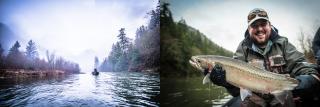
Recreational fishing attracts visitors which in turn supports a plethora of economic activity such as transactions for lodging, gas, food and local fishing guides. Photo courtesy of Salmon SuperHwy.
In fiscal year 2020, visitors to national forests alone contributed $13.5 billion to the Nation’s gross domestic product spending that helped sustain an estimated 161,000 full- and part-time jobs – more than any other industry.
Besides fish, anglers, and the local community there is another unlikely benefactor of the Salmon SuperHwy: local dairy farmers. The world-renowned dairy industry in the Tillamook- Nestucca region is a large part of the local economy and staunch supporters of the Salmon SuperHwy, but maybe for a reason one might not expect.
The region is ideal for dairy because of the abundance of annual rain, 94 inches of rain per year, and the resulting thick grass that grows, offering a nutritious diet to the area’s bovine. However, that same rainfall, about 60 inches over the national average, often causes flooding and washed-out roads resulting from those very same undersized culverts.
“Just like the fish have somewhere to go, so do the dairy farmers and their product,” said Capurso, “ “They both use those culverts at the road-stream crossings—the fish to pass upstream to spawn and the dairy farmers to transport their products to market.”
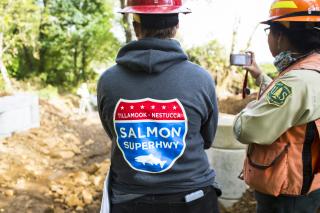
Approximately $10.7 million in funding has been used to fix barriers within the partnership, creating nearly 160 jobs. The Joint Chiefs‘ Landscape Restoration Partnership between the Forest Service, Natural Resources Conservation Service, and matching funds from partners provided approximately $6.6 million to that funding for the projects.
“We have to work with our neighbors across the entire watershed, we’re not going to succeed in our mission unless they succeed in theirs,” said Zwissler.
The land and natural resources, whether they be managed by state, federal or private landowners, are as interconnected as the streams in which fish swim. Now, with cooperation transcending borders it’s possible for land managers to work together to steward the whole stream for the benefit of the community, the industries, the health of the waterways, and the salmon that swim there.
The Salmon SuperHwy has attracted many partners across Federal and Local government as well private landowners and industries such as Tillamook County • Tillamook Estuaries Partnership • Tillamook County Creamery Association • Tillamook Bay Watershed Council • Nestucca-Neskowin Sand Lake Watershed Council • OR Dept of Fish and Wildlife • OR Dept of Forestry • OR Dept of Transportation • OR Watershed Enhancement Board • OR Fish Passage Task Force • US Fish & Wildlife Service • US Forest Service • Bureau of Land Management • Natural Resources Conservation Service • Trout Unlimited • Pelican Brewing Company and continues to grow.
Forest management best practices and partnerships between the Forest Service and NRCS are being shared across the country to restore landscapes, protect water quality, enhance habitat, and reduce the effects of extreme wildfire.